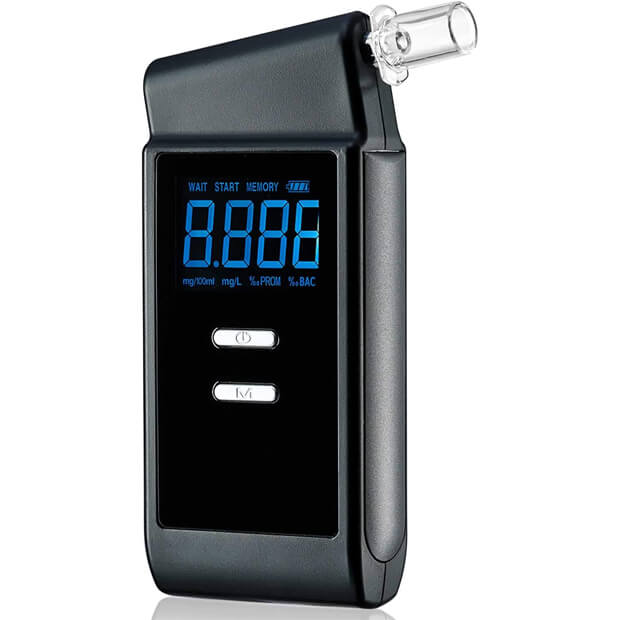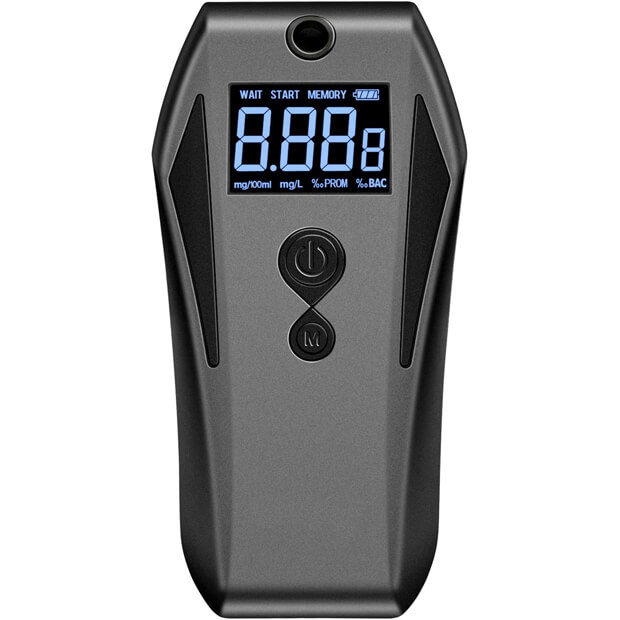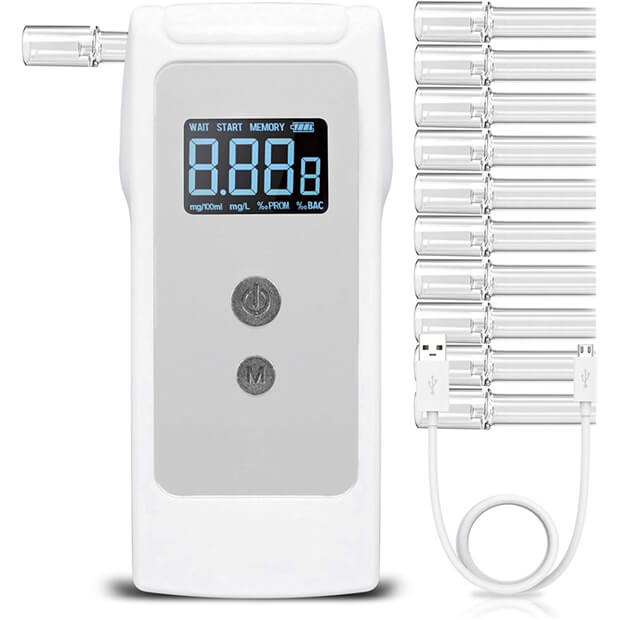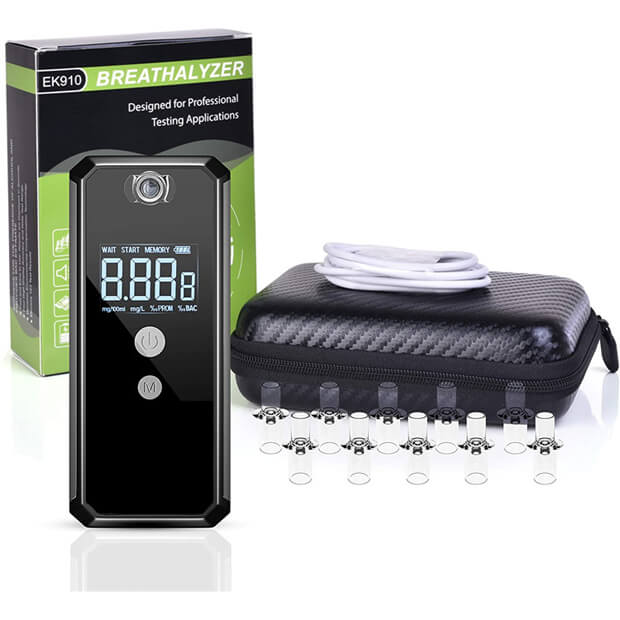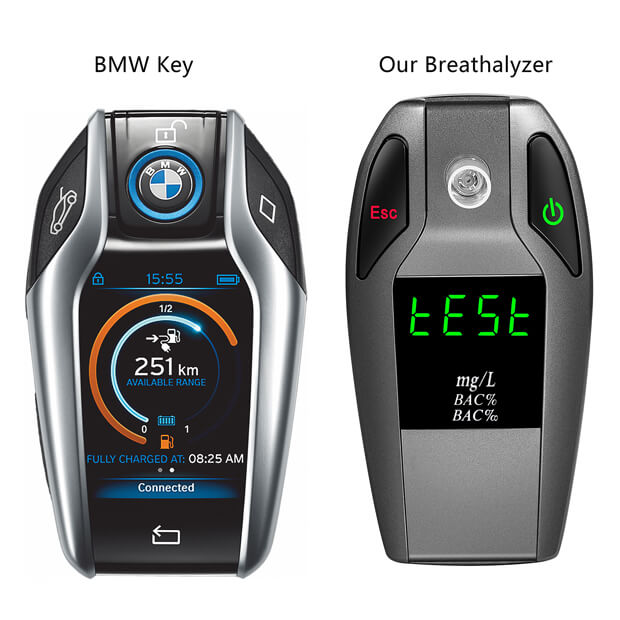Fuel Cell Alcohol Tester
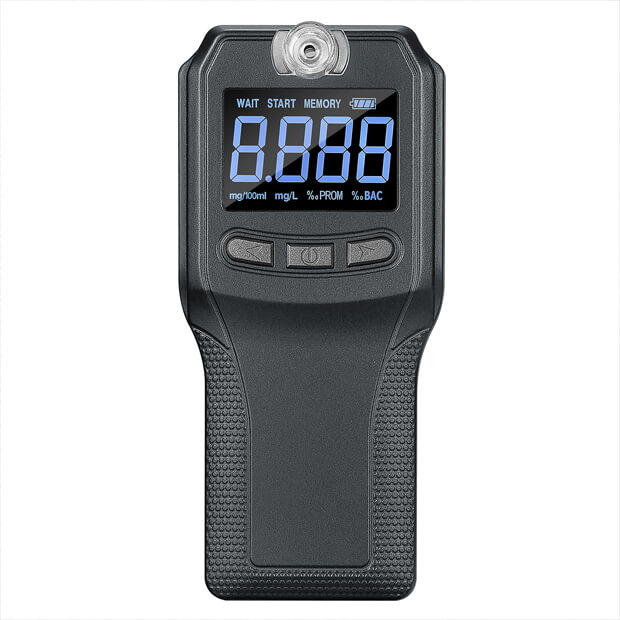
Alcohol testers with fuel cell sensor offer extremely high accuracy and sensitivity, employ the same advanced fuel cell technology that is used by police department for roadside alcohol testing, as well as in clinics, and businesses.
Fuel cell sensors rely on an electrochemical process that oxidizes the alcohol in a breath sample and produces an electrical current that the breathalyzer measures to determine the BAC.
Prices for fuel cell alcohol testers have come down in recent years, making them increasingly popular for personal use.
If you want the highest level of accuracy in your BAC readings,a professional level alcohol tester that uses fuel cell sensor technology would best suit you.
ODM/OEM Service
Exterior Design
Staffed with in-house specialized designers, your style concepts will be turned into reality. Any molding demand can be fulfilled.

Logo and Label
Your own logo can be laser printed on the products. Also brandedlabel stickers are available.

Package
The color box, inner box,and outer cartons canbe customized according to your artwork. Anybranded packages are accessible.

Fuel Cell Alcohol Tester
Fuel Cell Alcohol Tester
When you drink alcohol, it enters your stomach and small intestine. It enters your bloodstream and travels throughout your body, including to your brain and lungs. You exhale when you breathe. A breath test measures the amount of alcohol in your exhaled air. The breathalyzer uses this measurement to assess the level of alcohol in your blood by measuring blood alcohol content.
Alcohol breath testing is used by national institutes such as the police to identify whether a driver is inebriated. An individual's blood alcohol content is used to detect whether they are drunk by drinking. The amount of alcohol in the blood stream (i.e., the percentage) is measured in grams per deciliter of blood (e.g., a BAC of.05 percent translates to.05 grams of alcohol in every deciliter of blood). Using a portable breathalyzer to take a breath sample is a non-invasive solution. The intrusive way is to collect a breath sample with a portable breathalyzer; the non-invasive approach is to collect a breath sample with a portable breathalyzer. In an indirect approach, this breath test approximates the measurement of blood alcohol concentration (BAC). Portable breathalyzer testing has the following advantages over blood testing: it takes less time to give, produces faster results, is less expensive for the researcher, and can be done on the go.
Biology involved in alcohol consumption
When a person drinks alcohol, it passes through the stomach and small intestine and is quickly absorbed into the bloodstream. Within minutes of consuming an alcoholic beverage, a person's blood alcohol concentration (BAC) can be established. Your blood alcohol concentration (BAC) will be at its highest about an hour after you drink. Around 90% of the alcohol consumed is broken down by the liver, with the remainder expelled through urine and breath. The breath-testing device converts the amount of alcohol in a person's breath into a blood alcohol concentration (BAC).
The person's weight, gender, how much alcohol they've consumed, and when they last ate food are all factors that determine how quickly and how long their breath alcohol content rises. Only alcohol can be used in this type of test. In a similar vein, scientists are developing a mechanism to assess marijuana impairment.
The use of fuel cell breathalyzers as evidence proves that they can be used as accurate alcohol testers for alcohol breath testing. The amount of blood alcohol concentration (BAC) is used to legally define intoxication caused by alcohol. Obtaining a blood sample in the field for later laboratory evaluation is not practical or efficient for detaining drivers accused of driving while drunk or driving under the influence.
Because alcohol enters the bloodstream through the mouth, throat, stomach, and intestines, it appears in the breath. Alcohol is not metabolized or chemically altered in the bloodstream after it is taken. Because alcohol evaporates from a solution (it is volatile), some of it passes through the membranes of the air sacs (alveoli) in the lungs and into the air as blood flows through them.
The amount of alcohol in the alveolar air and the amount of alcohol in the blood are proportionate. The breath alcohol testing equipment can detect the presence of alcohol when alveolar air is breathed. Instead of drawing a driver's blood to determine his alcohol level, an officer can test the driver's breath on the spot and assess if the driver should be held immediately.
Fuel cell sensor
Alcohol testers using fuel cell sensors provide extremely high accuracy and sensitivity since they use the same advanced fuel cell technology that police departments use for roadside alcohol testing, as well as in clinics and companies.
Fuel cell sensors use an electrochemical process to oxidize the alcohol in a breath sample and produce an electrical current, which is measured by the breathalyzer to estimate the BAC. Fuel cell alcohol testers have become more affordable in recent years, making them more popular for personal usage.
A professional level alcohol tester with fuel cell sensor technology would be appropriate for you if you want the maximum level of precision in your BAC readings.
How Fuel Cell Breathalyzers Work
An electrochemical process is used by fuel cell sensors to oxidize the alcohol in a breath sample and produce an electrical current, which is detected by the breathalyzer to estimate the Blood Alcohol Concentration (BAC).
In a fuel cell, a porous acid-electrolyte material separates two platinum electrodes. As exhaled air passes through the fuel cell, the platinum oxidises any alcohol present, producing acetic acid, protons, and electrons. When electrons from the platinum electrodes flow through a wire, the Blood Alcohol Concentration (BAC) is disclosed. The amount of alcohol in the sample determines the current's strength.
Higher Accuracy and Longer Life
Fuel cell sensors in breathalyzers are more likely than semiconductor devices to produce the same test result in repeated, uninterrupted tests and sustain accuracy for substantially longer periods of time. The moisture in exhaled human breath is good to the sensor, therefore using a fuel cell breathalyzer on a regular basis can actually assist maintain the accuracy of the fuel cell. Regular use of a fuel cell breathalyzer can actually help maintain the accuracy of the fuel cell, as moisture in exhaled human breath is beneficial to the sensor.
Fuel cell-based testers also require significantly less frequent recalibration than semiconductor sensors – up to 1,500 tests or once a year – and regular use of a fuel cell breathalyzer can actually help maintain the accuracy of the fuel cell, as moisture in exhaled human breath is beneficial to the sensor. Unlike semiconductor sensors, a fuel cell sensor will not create a false positive in diabetics or people on a low-calorie diet. Even when there is no alcohol present, semiconductor devices can react to cigarette smoke, breath acetone, and volatile chemicals like hairspray and gasoline vapor, generating positive alcohol readings.
Limitation
Measurement error is a great concern for field researchers using breathalyzers to record data on alcohol consumption. According to study, three principle components influence Blood Alcohol Concentration (BAC) measurement uncertainty: biological/sampling errors (e.g., breathing patterns); instrumental differences (e.g., device calibration), and traceability (i.e., inferences). Biological errors create the most uncertainty, but when combined these components can produce a cumulative effect impacting the precise measurement of Blood Alcohol Concentrations. Researchers should control for degree of uncertainty when using Blood Alcohol Concentration (BAC) readings by limiting measurement error, and the more reliable an instrument, the smaller the measurement error will be.
Advantages
High accuracy:
Fuel cell sensors have better accuracy and consistency than semiconductor sensors. Always give accurate values within the test range.
Specificity:
The fuel cell sensor can always remain alcohol-only responsive. Unlike semiconductor sensors, they are subject to other gases. If the user is on a ketogenic diet, the semiconductor alcohol tester will also give a value for the ketone gas detected. This makes the sensor output unreliable and could lead the instrument to trigger false alarms.
Calibration stability:
Electrochemical sensors do not need to be calibrated frequently, usually once a year. Semiconductor sensors are prone to baseline shifts over time and the calibration is usually required on a semi-annual basis.
Reliability:
Electrochemical sensors have short preparation time and are not easily affected by previous results. They can be continuously tested. When a semiconductor is being tested continuously, a period of rest is required.
Long life:
The expected life of a fuel sensor is 3 to 5 years.

